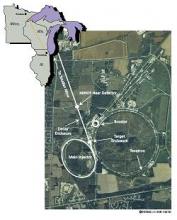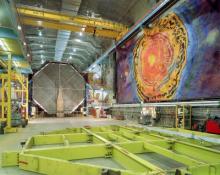About the Project
- The main goal of the MINOS experiment is to study the phenomenon of neutrino oscillations in a controlled accelerator experiment and to measure the oscillation parameters.
- A beam of muon neutrinos is produced from protons extracted from the Main Injector at Fermilab, just outside Chicago. These are detected 735 km away in the main 5400 ton MINOS 'far' detector half a mile underground in the Soudan mine. In addition a smaller 'near' detector is located 290 m from the decay pipe.
- Some of the muon neutrinos oscillate to become tau neutrinos during the journey to the Soudan mine. Neutrino oscillations are investigated by studying and comparing the rates and energy spectra of Charged Current interactions in the MINOS near and far detectors.
 Cavendish HEP Group involvement
Cavendish HEP Group involvement
- The Cambridge group has concentrated on the following areas:
- The study of atmospheric neutrino interactions in the MINOS detector, results from the first eight years of data will be published early in 2012.
- Analysis of charged current beam interactions - the main goal of the MINOS experiment.
- Development of a new pattern recognition technique for the search for rare muon to electron neutrino oscillations in the beam data. Important results from recent data have provided an indication for a positive signal.
- Data taking is likely to end late 2011, whilst the Fermilab beam is upgraded. It is expected that a new phase of operation, MINOS+, will follow.

